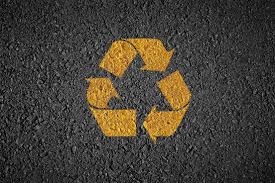RAP in SC – Our paving industry could be facing a dilemma in becoming greener!
RAP in SC – Our paving industry could be facing a dilemma in becoming greener!
 When anyone thinks of recycling materials, most folks look at what they recycle each week at their households which includes paper products, aluminum cans, and glass bottles. Yes, depending on how hot it is on the lake during the summer or even after a big weekend of football, my "Herbie Curbie” can be full!
When anyone thinks of recycling materials, most folks look at what they recycle each week at their households which includes paper products, aluminum cans, and glass bottles. Yes, depending on how hot it is on the lake during the summer or even after a big weekend of football, my "Herbie Curbie” can be full!
One thing is certain, recycling is great, but it is not free! It cost money to process the RAP through crushing, and even your materials that you recycle in your household must go through a tedious sorting and cleaning process, and later a shredding and crushing process that all cost money for those materials to be reused. But what most of the public doesn’t understand is that our asphalt industry produces the world’s most recycled product! Yes, our asphalt mix is currently 100% recyclable, and we should take pride in this fact. We use on average 23% RAP in all our pavements here in SC. Some producers have more, while some have very little. This is usually due to either specifications are set to permit a maximum percentage or at times this is just a balance of your plant operations. These operations may be related to the amount of RAP that your organization has available to use to keep supplying the average, or maybe its your asphalt plant. Everyone’s asphalt plant is designed to run some percentage of recycled material nowadays. The plant capacity and efficiency are key to running the RAP to maximize production, maintain proper temperature to ensure mixing and consistent mixture, and of course maintain a quality product that will last its intended life cycle.
The future of RAP is key to success in many ways, it is the right thing to do – recycle! This material has value even after serving as the road for the traveling public for 15-20 years. The RAP has ($) value in the raw materials saved from not having to mine new aggregate from the earth and extract new oil and refine to make new asphalt binder. The savings is normalized in the overall cost of the finished product here in SC. This means that the overall cost of the new mix that contains some percentage of recycled material should be less expensive compared to a 100% virgin mix, and this is often shown in the cost per ton of the asphalt mix. The RAP adds strength to the new mixture with added rut resistance, and with today’s additives the mix can also be as flexible and can even outperform a new virgin design.
Looking forward – ahead into the future, but not too far, we must continue to find ways to use more RAP. This is important not only to become greener, but to meet future regulations being introduced by our federal government. These regulations require a lower carbon footprint on the mix we produce every day to get future contracts. One obvious way to reduce your carbon footprint is to reduce energy consumption through your plant’s fuel and electricity consumption. The other major contributors to a lower carbon mixture are lowering the amount of virgin asphalt binder and lower travel distance to get new aggregate materials which both are directly affected by the amount of RAP you elect to use. So, by stating this fact, we need to investigate ways to increase our RAP, by allowing more freedom in the specifications and more importantly finding means to get more RAP to use. The current use of RAP for the most part is in balance in most urban markets, however, to increase the size of these stockpiles, we need to do more mill and fill work. I mentioned the urban markets due to the number of roads that must be milled due curbs, and these areas are usually found near Interstates where the roads need to maintain elevations for bridge clearance and drainage requiring milling operations.
In this state, we use a process called CMRB (Cement Modified Recycled Base), where the road is recycled (good) in place along with adding Portland cement to gain strength. Depending on the current road, and the pavement design, usually the best CMRB candidates have 40-70% old pavement recycled along with the in situ granular or earth base materials.
This percentage of old pavement needs the fines from the base to make a quality CMRB product that will compact tight and seal out water. We must continue to ask for increased focus on doing more investigations up front for the roads to be selected for CMRB. This usually entails someone doing an on-site visit to the road in question and taking depth checks of the pavement. Other investigations can be done later after the bidding process if the preliminary work is thorough, but those are usually focused on sampling for mix designs and finding out what is below the existing pavement. We should be asking for this info up front of the bidding process to make the contracts go smoother with less interruptions during construction and with less change orders. So, circling back to the RAP issue, we need to do more pre-milling of these roads to collect this RAP if we are going to become more carbon neutral in the future, the truth is currently we simply don’t have enough RAP for this to happen!
